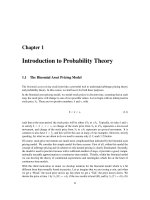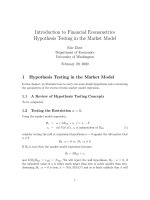INTRODUCTION TO MARKETING
Bạn đang xem bản rút gọn của tài liệu. Xem và tải ngay bản đầy đủ của tài liệu tại đây (236.26 KB, 44 trang )
Introduction to Marketing
Duong, Nguyen Thanh
FTU2 - ICCC
What is marketing?
‘Marketing is the management process that
identifies, anticipates and satisfies customer
requirements profitably’
‘The right product, in the right place, at the
right time, and at the right price’
Contd…
‘Marketing is the human activity directed at
satisfying human needs and wants through an
exchange process’
Kotler 1980
‘Marketing is a social and managerial process
by which individuals and groups obtain what
they want and need through creating, offering
and exchanging products of value with others’
Kotler 1991
For an exchange to occur…..
There are at least two parties.
Each party has something that might be
of value to the other party.
Each party is capable of communication
and delivery.
Each party is free to reject the exchange
offer.
Each party believes it is appropriate or
desirable to deal with the other party
What is Marketed?
Goods
Services
Events
Experiences
Persons
Places
Properties
Organizations
Information
Ideas
Key Customer Markets
Consumer markets
Business markets
International Markets/Global markets
Nonprofit/Government markets
Evolution of Marketing
Production Era
Sales Era
Marketing Concept Era
Societal Era
1. Production Orientation
Focuses on internal capabilities of firm.
“ Field of Dreams” strategy
“If we build it, they will come”
Best used when
competition is weak
demand exceeds supply
generic products competing solely on price
Problem is that they don’t understand
wants/needs of marketplace.
2. Sales Orientation
People will buy more goods/services if
aggressive sales techniques are used.
High sales will result in high profits.
Used with unsought products
life insurance
encyclopedias
Problem is that they don’t understand
wants/needs of marketplace.
I can sell everything, if I know how to
sell it
3. Marketing Orientation
Marketing concept
The social and economic justification for an
organization’s existence is the satisfaction of
customer wants and needs, while meeting
organizational objectives.
3. Marketing Orientation . . .
Focusing on customer wants so the
organization can distinguish its products
from competitors’ .
Integrating all the organization’s
activities, including promotion, to satisfy
these wants.
Achieving long term goals for the
organization by satisfying customer
wants and needs legally and
responsibly.
3. Marketing Orientation . . .
Requires:
Top management leadership
A customer focus
Competitor intelligence
strengths
weaknesses
Inter-functional coordination to meet
customer wants/needs and deliver superior
values.
4. Societal Marketing
Orientation
Organization exists not only to satisfy
customer wants/needs and to meet
organizational objectives, but also to
preserve and enhance individuals’ and
society’s long-term best interests.
Extends marketing concept to serve one
more customer - society as a whole.
Differences between Sales &
Marketing Orientations
Production/Sales
Focus
Organization’s needs
Producing/Selling
goods/services
Everybody
Profit through max.
sales volume
Intensive promotion
Marketing Focus
Customer’s needs
Satisfying customer
wants/needs
Specific groups of
people
Profit through customer
satisfaction
Coordinated mktg.
activities (4 p’s)
Marketing Philisophies
Orientatio Key Ideas
n
Productio
n
Focus on efficiency of internal operations –
if we make it, they will buy it
Sales
Focus on aggressive sales techniques and
believe that high sales result in high profits
Marketing Focus on satisfying customer needs and
wants
while meeting objectives - if they will buy it,
we will make it
Societal
Focus on satisfying customer needs and
wants while enhancing individual and
societal well-being. I.e.-mfg using
recyclables
Relationship Marketing
Forging long-term partnerships with
customers and contributing to their
success.
Companies benefit from
repeat sales/referrals that lead to increases
in sales, market share and profits, and
decreased costs - it’s less expensive to serve
existing customers than attract new ones.
3. Relationship Marketing. . .
Customers benefit from:
stable relationships with suppliers (especially
in business-to-business)
greater value and satisfaction
discounts, (frequent flyer programs, shopper
clubs, etc.)
3. Relationship Marketing . . .
Successful relationship marketers have:
customer-oriented personnel
effective training programs
employees with authority to make decisions
and solve problems
teamwork
Marketing Mix and the
Customer
Four Ps
Product
Price
Place
Promotion
Four Cs
Customer
solution
Customer cost
Convenience
Communication
Core Concepts
Needs, wants, and
demands
Target markets,
positioning,
segmentation
Offerings and
brands
Value and
satisfaction
Marketing
channels
Supply chain
Competition
Marketing
environment
Marketing
planning
Implications of marketing
Who are our existing / potential
customers?
What are their current / future needs?
How can we satisfy these needs?
Can we offer a product/ service that the
customer would value?
Can we communicate with our customers?
Can we deliver a competitive product of
service?
Why should customers buy from us?
Successful marketing
requires
Profitable
Offensive (rather than
defensive)
Integrated
Strategic (is future orientated)
Effective (gets results)
Marketing management
process
Analysis/Audit - where are we
now?
Objectives - where do we
want to be?
Strategies - which way is best?
Tactics - how do we get there?
Implementation - Getting there
Control - Ensuring arrival
CONTROLLABLE FACTORS
AFFECTING MARKETING DECISIONS
The Four P’s
-the “arrow”
Price
Price
Promotion
Promotion
Place
Place
Product
Product
UNCONTROLLABLE FACTORS
AFFECTING MARKETING DECISIONS
Social
Social
Natural
Natural
Economic
Economic
External
External
Environmental
Environmental
Factors
Factors
Technologic
Technologic
Political
Politicaland
andLegal
Legal
Competitive
Competitive
Helps identify market opportunities
![[CEH V3] Introduction to Ethical Hacking](https://media.store123doc.com/images/document/13/ly/ap/medium_3ABUW8WdDH.jpg)








